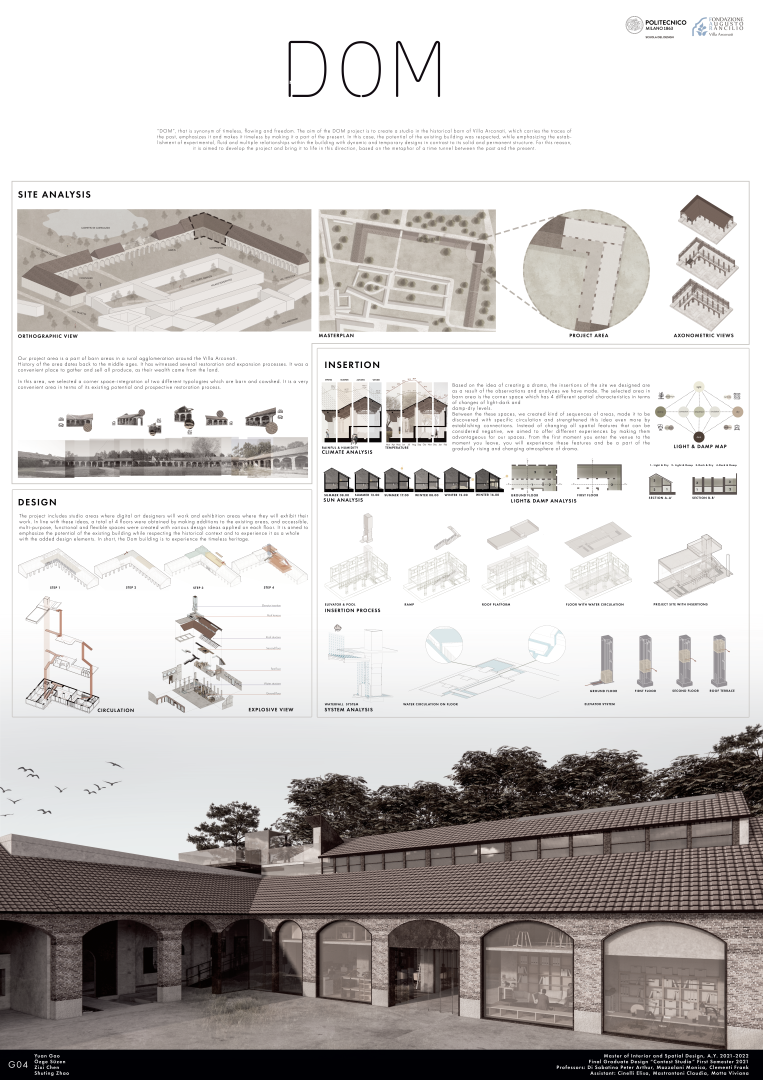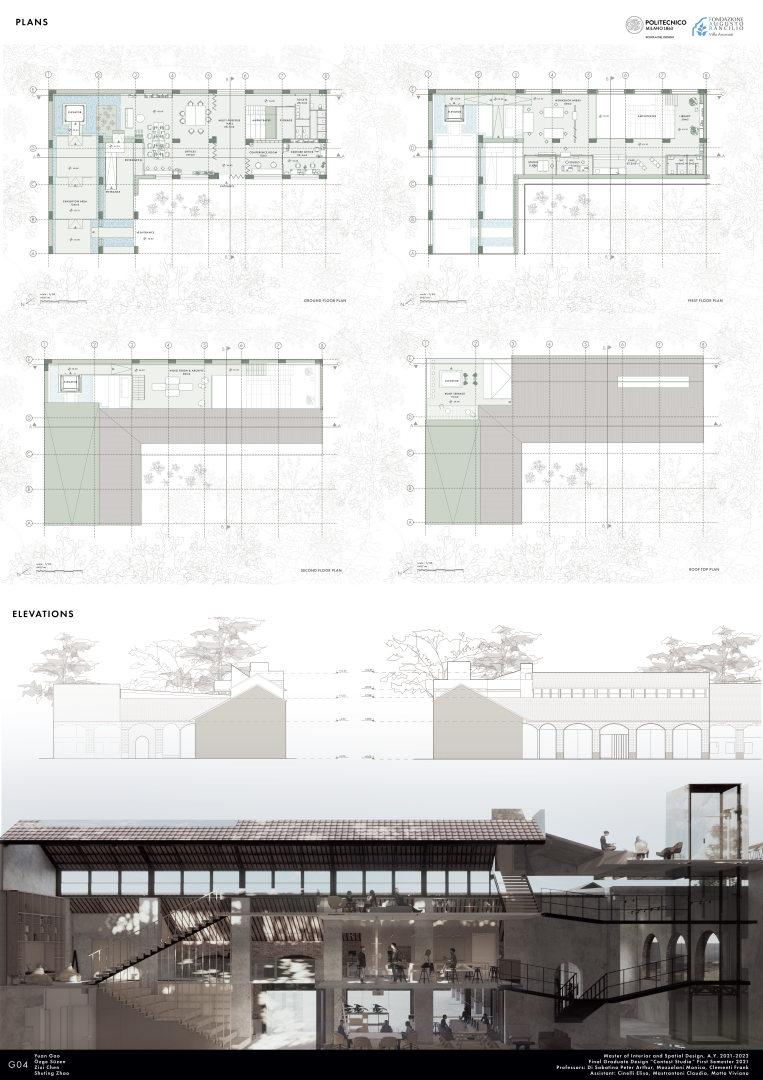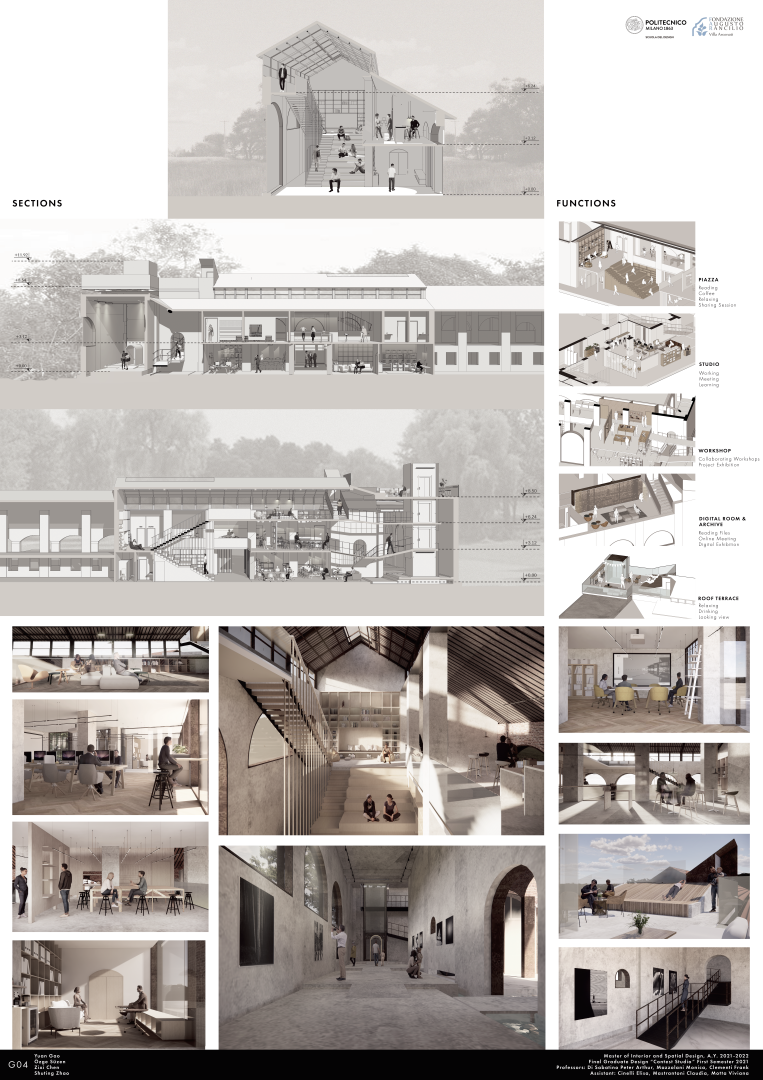DOM
Basic information
Project Title
Full project title
Category
Project Description
DOM is to create a studio in a historical barn of Villa Arconati where digital art designers will work and exhibition areas to exhibit their work. This project, inspired by nature and created with the participation of nature itself in the design process, has made the interior space transparent and brought its users closer to nature. It obtained by making additions to the existing areas, and accessible, multi-purpose, functional and flexible spaces were created to emphasize the potential.
Geographical Scope
Project Region
Urban or rural issues
Physical or other transformations
EU Programme or fund
Which funds
Description of the project
Summary
The project area is a part of a barn in a rural agglomeration around Villa Arconati, Milan. In this area, we selected a corner space-integration of two different typologies which are barn and cowshed. It is a very convenient area in terms of its existing potential and prospective restoration process.
This project, inspired by nature and created with the participation of nature itself in the design process, has made the interior space transparent and brought its users closer to nature. The selected area in barn area is the corner space which has 4 different spatial characteristics in terms of changes of light-dark and damp-dry levels.
Between the these spaces, we created kind of sequences of areas, made it to be discovered with specific circulation and strengthened this idea even more by establishing connections. Instead of changing all spatial features that can be considered negative, we aimed to offer different experiences by making them advantageous for our spaces. From the first moment you enter the venue to the moment you leave, you will experience these features and be a part of the gradually rising and changing atmosphere of drama.
The project includes studio areas where digital art designers will work and exhibition areas where they will exhibit their work. In line with these ideas, a total of 4 floors were obtained by making additions to the existing areas, and accessible, multi-purpose, functional and flexible spaces were created with various design ideas applied on each floor. It is aimed to emphasize the potential of the existing building while respecting the historical context and to experience it as a whole with the added design elements. In short, the Dom building is to experience the timeless heritage.
Key objectives for sustainability
We referenced "rainwater" as a circulation in the environment in the project. This concept not only connects the relationship between space and nature, but also expresses our thinking on how to create sustainable development in space design. We hope to use the circulation display of water to refer the flow changes of elements in nature to the interior space , creating different design ideologies. In the project exhibition hall, we used recycled water as a guide. According to the changes of time and light and shadow, natural elements became an essential part of our design. In the whole project, our streamline is also a big cycle as a whole. You can start from different places, meet at the same place, or start from the same place and go to different spaces. Increase user experience.
Key objectives for aesthetics and quality
“DOM”, that is synonym of timeless, flowing and freedom. The aim of the DOM project is to create a studio in the historical barn of Villa Arconati, which carries the traces of the past, emphasizes it and makes it timeless by making it a part of the present. In this case, the potential of the existing building was respected, while emphasizing the establishment of experimental, fluid and multiple relationships within the building with dynamic and temporary designs in contrast to its solid and permanent structure. For this reason, it is aimed to develop the project and bring it to life in this direction, based on the metaphor of a time tunnel between the past and the present.
Key objectives for inclusion
We used three different modes of channel forms in the project and combined them. People with limited mobility can use a combination of elevators and ramps, while stairs can be used for everyday use. At the same time, these three channels are not just used as aisles, we have added other uses on the basis of guaranteed functions. For example, the grand staircase connecting the first floor can also be used as a leisure area, people can sit on the big steps to chat, rest, and even hold salon events. The elevator combines the elements of water, you can enjoy the light and shadow and changes when you take the elevator, and you can enjoy the flow of rainwater when it is raining. On both sides of the ramp in the semi-outdoor area, exhibitions can be held, and people can browse the exhibits when passing through the ramp. The project also highlights the flexibility and playfulness of the overall space while ensuring functional integrity. And considering the needs of different groups of people, it emphasizes the inclusiveness of the space and the sense of public participation in many aspects.
Physical or other transformations
Innovative character
All three-dimensional systems we designed for our concept, where we act on bringing natural elements into the interior or using them without changing them, support this idea and strengthen the bio-architecture approach we want to apply to the interior. With this approach, which has become increasingly popular especially after Covid, it is aimed to bring the user closer to nature indoors. At the same time, the need for the use of this approach has increased gradually, with its psychological and physical healing effect on the user. The adoption of this approach in the office designs we have seen recently, especially the inclusion of natural elements in the working environments, has affected the beginning of our concept idea and accordingly the shaping of our design elements. While doing this, instead of being static, all the systems we use were inspired by the ever-changing and continuous aspect of nature, and it was enabled to continue in the interior as an active and to experience the process in nature by interacting with the user one-to-one. For example, the rain system we have designed provides a reason for users who comes inside on rainy days to experience the rain process theirselves, and to turn to nature. The system does not use any water source, it carries the rain inside and allows the user to interact with it indoors. In the water pools where the rain accumulates, it provides the continuous flow of water along the wall throughout the space, and this is no different from the water cycle in nature. By playing a decisive role for the circulation with the flow direction in the space, it enables to follow the water flow, consciously or unconsciously, similar to the attitude of the human being in nature. At the same time, the light and damp analyzes created an environment for the functional and experiential differentiation of the spaces within themselves, and it played an important role by providing the most suitable conditions for our designs.



